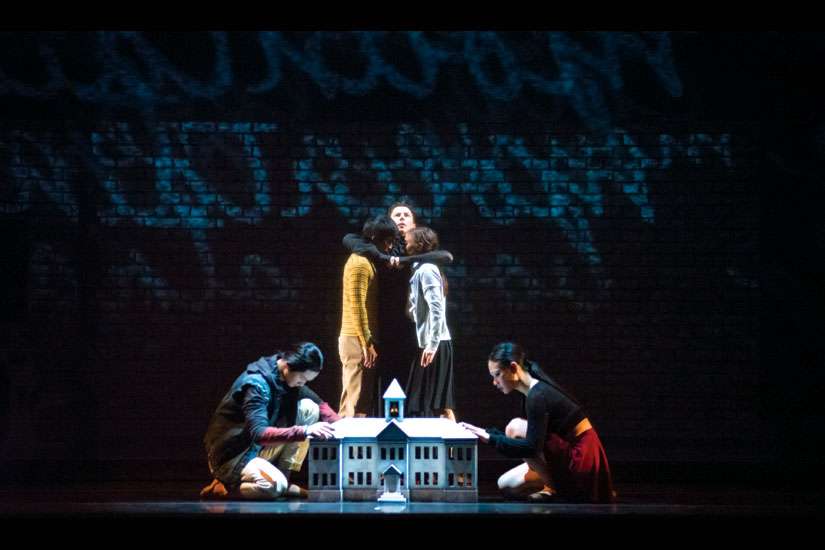So while the Truth and Reconciliation Commission (TRC) of Canada has been collecting art to express the experiences at Indian residential schools, it has commissioned and supported artists across the country to commemorate this part of Canadian history.
The Royal Winnipeg Ballet, in partnership with the TRC, created Going Home Star — Truth and Reconciliation, an original contemporary ballet about the Indian residential school system.
The ballet premiered in Winnipeg last October. Following its local success, the Royal Winnipeg Ballet is taking the production across the country, starting Jan. 28 in Ottawa.
“From (the TRC’s) point of view, no matter what the ballet would be, their message would reach people that normally wouldn’t be reached,” said Mark Godden, choreographer and co-creator of Going Home Star. “It’s a subject matter that we have talked about in the past... and even though I’m not of aboriginal descent, it was something the company really wanted to do.”
Godden said while most of the cast and crew of the production are not of aboriginal descent, they were all eager to immerse themselves in the culture. In collaborating with the TRC, honorary witnesses and elders often visited the rehearsals and shared their insights with the ballet company. One obstacle Godden encountered for himself was the idea of incorporating aboriginal history and tradition.
“I was kind of despairing of the fact that we might somehow be exploiting these people again for our own personal art form,” said Godden. “I wanted to be true to these stories, but I also wanted to be true to the ballet world.”
Eventually, Godden found the bridge in the music. He contacted Juno award-winning composer Christos Hatzis. Hatzis brought with him famed Inuk throat singer Tanya Tagaq, Steve Wood and the Northern Cree Singers. The music became the spirit of the aboriginal history and tradition, which freed Godden to be true to the classical movement of ballet. All that was left was the story.
In researching the story, Godden’s first impulse was to connect with the TRC as it collected first-hand accounts from residential school survivors. He watched hours and hours of live-stream footage from town hall meetings across the country.
“Once I witnessed so many of these stories, I realized that these (stories) were still raw. It’s still an open wound,” said Godden. “I was pretty devastated listening to it.”
Godden said he started out wanting to capture the real emotions from real witnesses. But in hearing testimony, he realized these stories were so personal and raw that it didn’t feel right exploiting their experiences for the ballet.
Instead, he decided to work with Canadian author and TRC honorary witness Joseph Boyden to create a fictional story that reflected the life of residential school survivors but through a contemporary perspective.
“Understanding how to write for a ballet was the hardest part,” said Boyden. “I didn’t have to do a lot of research on the First Nations. That’s what I’ve been doing for all of my writing life... I’ve never written for a ballet before and I wasn’t sure how to go about it. I was nervous, but also intrigued.”
While he was on a book tour for his last novel, The Orenda, Boyden was struck with the idea. The heart of the ballet would centre around the aboriginal teachings of the four directions and the traditional First Nations colours they represent.
The main character, Annie, is a young, urban First Nations woman. She represents South and red. She is a free-spirited, contemporary woman living in the city.
Annie passes Gordon every day in the subway. He is North and represents the colour white. He is a homeless guy, but tough. As the ballet progresses, Gordon introduces Annie to two others through a window that flashes back to the residential schools. Niska represents West and the colour black. She’s a young aboriginal woman who comes from a family of healers. Her family was forced to give her up and places her in a residential school. She is earthy and strong-willed and fights the priests and nuns at every turn.
Charlie is a child of the East and represents yellow. He is also imprisoned in a residential school of the past, but he believes if he follows the rules, he will eventually see his family again. Throughout, the characters must wrestle for their souls and their identities. It is a dramatic struggle that ends in hope for healing in the future.
Godden and Boyden agreed the story and emotion had to be rooted in the real-life experiences of school survivors, but the story is also meant to be uplifting.
“I didn’t want to approach this story from just one angle of the residential school in the past,” said Boyden. “I wanted to tell a story that captured the here and now... and approaching it that way, I was able to try to paint a picture of a real possibility of reconciliation.”
Boyden adds a ballet needs a dramatic story to carry the music and the movement forward. He hopes this story will not only speak to the survivors or audience, but also to the young people who are inheriting the responsibility of the reconciliation.
“I don’t necessarily think that there’s a disconnect between young people and what has happened, but they certainly see the fallout from
their parents and grandparents,” said Boyden. “I want the audience member to understand that this is not just something in the past, that reconciliation is going to be an ongoing issue for this country for a long time to come and that we’re all a part of this.”
Visit rwb.org for tour details.


